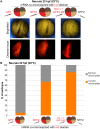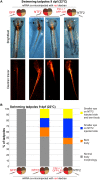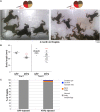Altering the levels of nuclear import factors in early Xenopus laevis embryos affects later development
- PMID: 31009515
- PMCID: PMC6476522
- DOI: 10.1371/journal.pone.0215740
Altering the levels of nuclear import factors in early Xenopus laevis embryos affects later development
Abstract
More than just a container for DNA, the nuclear envelope carries out a wide variety of critical and highly regulated cellular functions. One of these functions is nuclear import, and in this study we investigate how altering the levels of nuclear transport factors impacts developmental progression and organismal size. During early Xenopus laevis embryogenesis, the timing of a key developmental event, the midblastula transition (MBT), is sensitive to nuclear import factor levels. How might altering nuclear import factors and MBT timing in the early embryo affect downstream development of the organism? We microinjected X. laevis two-cell embryos with mRNA to increase levels of importin α or NTF2, resulting in differential amounts of nuclear import factors in the two halves of the embryo. Compared to controls, these embryos exhibited delayed gastrulation, curved neural plates, and bent tadpoles with different sized eyes. Furthermore, embryos microinjected with NTF2 developed into smaller froglets compared to control microinjected embryos. We propose that altering nuclear import factors and nuclear size affects MBT timing, cell size, and cell number, subsequently disrupting later development. Thus, altering nuclear import factors early in development can affect function and size at the organismal level.
Conflict of interest statement
The authors have declared that no competing interests exist.
Figures




References
-
- Misteli T, Spector DL. The Nucleus. Cold Spring Harbor, New York: Cold Spring Harbor Laboratory Press; 2011. 517 p.
Publication types
MeSH terms
Substances
Grants and funding
LinkOut - more resources
Full Text Sources

